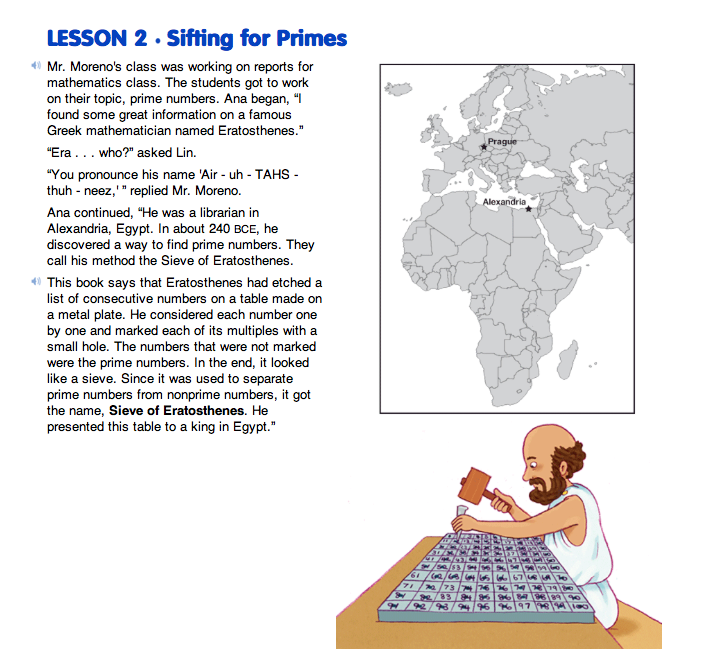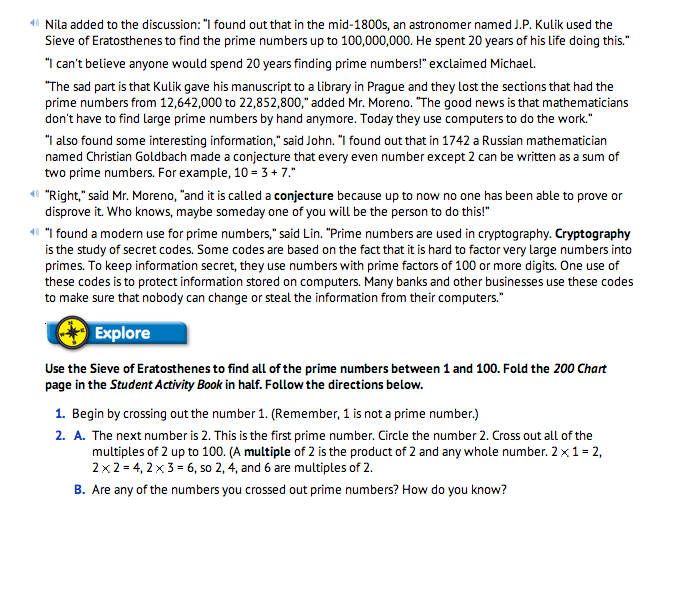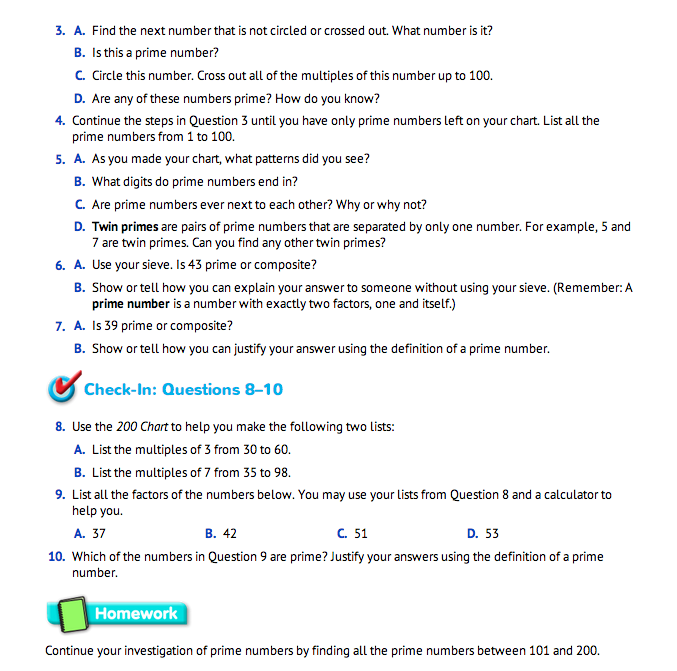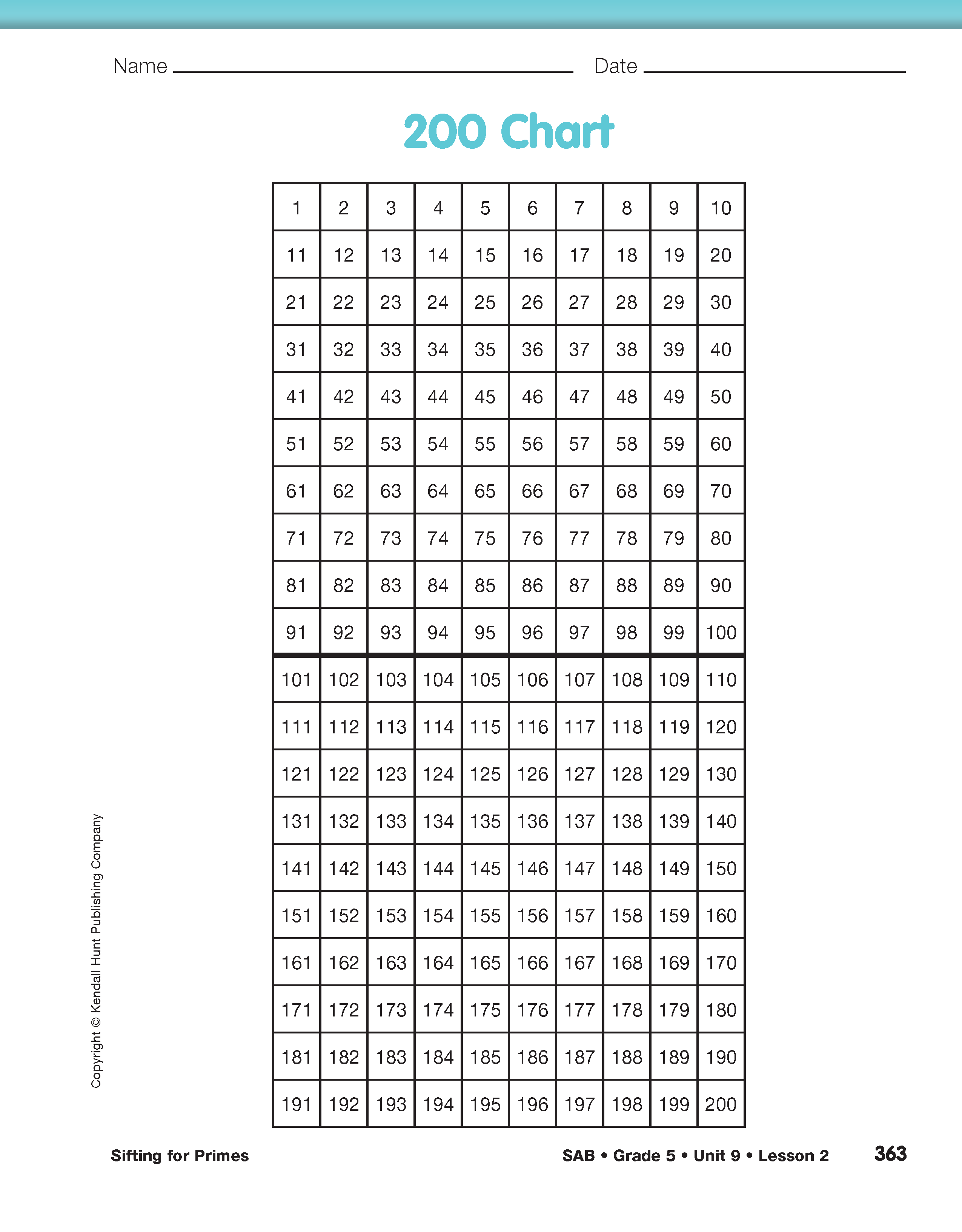Define Sieve. Read the vignette on the Sifting for Primes pages in the Student Guide as a class or in small groups.
Students may be more familiar with a colander, a type of sieve used in the kitchen to separate liquids from solids. Just as a colander is used to separate water from something like pasta, the Sieve of Eratosthenes is used to separate non-prime numbers from prime numbers.
If you have a colander or a strainer at home, you can bring it in to show students an example of a sieve.
Use the Sieve. After reading and discussing the information in the Student Guide, students may begin sifting for the prime numbers between 1 and 100 on the 200 Chart page in the Student Activity Book. Ask students to fold their charts so they see only the numbers 1 to 100. They should follow the directions in Questions 1–4 in the Student Guide. Students will complete their work on the 200 Chart page as they sift for the prime numbers between 101 and 200 for homework.
Using a display of the 200 Chart page, ask a volunteer to model filling in the chart for the first few numbers as the other students work at their seats. See Figure 1.
After crossing out the number 1, circle the first number on the chart, which is the number 2.
As students begin working on their sieves, ask:
- Which numbers are multiples of 2? How can you find multiples of 2? (All of the even numbers are multiples of 2; I can skip count by 2s.)
- What do you notice about crossing out the multiples of 2? (Possible response: The even numbers fill every other column. All of the numbers in these columns can be crossed out except for the number 2.)
- Are any of the numbers you crossed out prime numbers? (No; they all have 2 as a factor. They are all composite numbers.)
- What is the next number that has not yet been circled or crossed out? (3)
- Is this a prime number? (Yes, its only factors are 1 and 3. It should be circled.)
- Which numbers on the chart are multiples of 3? How can you find multiples of 3? (Skip count by 3s to find all the multiples of 3; use divisibility rules to check whether numbers are multiples of 3.) [See Content Note.]

Divisibility Rules. If one number (A) is a multiple of another number (B), then we can also say that A is divisible by B. We can say this because dividing A by B results in a whole number quotient. Therefore, divisibility rules can be used to determine if A is a multiple of B. For example, since 48 is a
multiple of 6 (6 × 8 = 48), we can also say that 48 is divisible by 6. The rule for checking divisibility by 6 verifies this. Namely, 48 is even so it is divisible by 2, its digits add up to 12 (which is divisible by 3) so it is divisible by 3, and it is therefore divisible by 6.
When to stop looking for primes. Students should be allowed to work until they have convinced themselves that the only numbers left are prime numbers. This may mean that some students will need to continue looking for the multiples of each number that has not been crossed out on the chart or they may discover that they have to cross out only the multiples of prime numbers. See Figure 1.
- When were you sure that all the remaining numbers in the chart were primes and not composite numbers that had not yet been crossed out?
To help them think about this, lead them to consider the following facts by asking:
- Why did you cross out the even numbers? (because they were multiples of 2)
- When you crossed out multiples of 3, which multiples were already crossed out? (Some of them were also multiples of 2 and already crossed out.)
- When crossing out multiples of 5, which multiples were already crossed out? (The numbers that were also multiples of 2 or 3, such as 30 and 45, were already crossed out.)
- When crossing out multiples of 7, which multiples were already crossed out? (the multiples of 7 that are also multiples of 2, 3, or 5)
- What pattern do you see? (When crossing out multiples of a number, the numbers that are also multiples of smaller primes have already been crossed out.)
As students follow the steps of the Sieve of Eratosthenes to find prime numbers less than 100, they may notice that, after a few steps, most of the composite numbers have been crossed out. They might wonder when they can stop looking for multiples of primes and still be sure they haven't missed any. It turns out that they need to cross out only multiples of the primes less than 10; these are 2, 3, 5, and 7. After crossing out multiples of those primes, the multiples of larger primes will have already been crossed out and the remaining unmarked numbers are all prime. For example, the next prime after 7 is 11. The first several multiples of 11 (2 × 11, 3 × 11, 4 × 11, 5 × 11, 6 × 11, and so on) are also multiples of 2, 3, 5, or 7, so they have already been crossed out. The smallest multiple of 11 that is not also a multiple of 2, 3, 5, or 7 is 11 × 11. But 11 × 11 is greater than 100 so it is not on the chart.

Using Overlays. After students have completed their sieves through 100 and discussed their solutions, you may show students a completed sieve by using overlays, one at a time. On the first one, circle 2 and cross out all the multiples of 2. On the second, circle 3 and cross out all the multiples of 3. On the third, circle 5 and cross out all the multiples of 5. Complete the fourth by circling 7 and crossing out the multiples of 7.

Prime Numbers. After reading the vignette in the Student Guide, you may want to give students some additional information about prime numbers:
- No one has proven or disproven Goldbach's conjecture that every even number except 2 can be written as the sum of two prime numbers. However, in 1993 a computer did verify that the conjecture is true for every even number except 2 up to 100 million.
- There are infinitely many prime numbers. Prime numbers occur less frequently among large numbers. For example, there are 168 prime numbers between 1 and 1000. There are only 75 primes between 1,000,000 and 1,001,000. Both of these intervals include 1000 numbers, but there are more primes in the interval 1 to 1000.
The Sieve of Eratosthenes asks us to cross out only multiples of prime numbers. That crosses out multiples of composite numbers, too. For example, crossing out multiples of 2 includes crossing out multiples of 6.


















